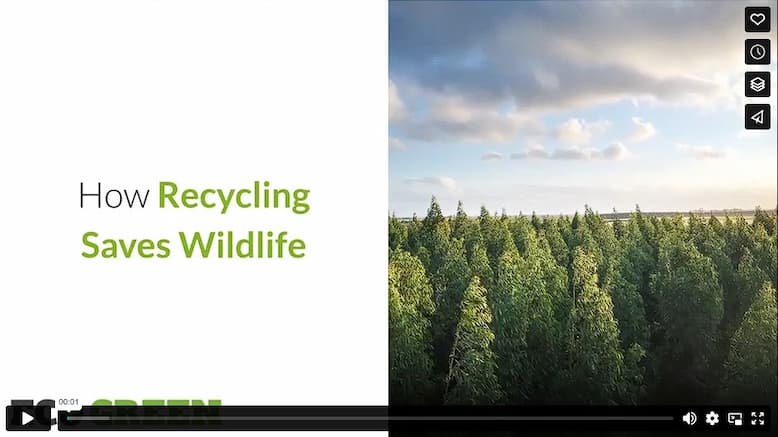In 2019, the Environmental Protection Agency (EPA) recognized the progress that we have made as a country in our recycling efforts. Since 1960, recycling efforts have increased from only 7% to 32%. While that is a significant increase, it still leaves a lot of room for improvement if we want to protect the Earth and all its inhabitants. Everything that we discard in our homes and offices has to go somewhere, and despite our best efforts to minimize the environmental impact of our trash, it still affects the plants and animals in ways that we may not realize. Our every effort to recycle reduces that impacts and preserves lives.
1. Shrinks Landfills
According to current EPA estimates, the average American produces about five pounds of trash each day. If we multiply the number by the number of people living in the United States and the number of days in a year, it is shocking that we find space each year to dispose of it all. Some trash is incinerated, but much of it is buried in landfills. These landfills pollute the ground and monopolize land where animals could graze or live. Instead, it becomes a toxic burial ground for food waste, plastic products, and clothing, some of which will not decompose for decades. If we take the time to separate the trash from the recyclable materials, we could significantly reduce the amount of waste sent to landfills each year.
2. Preserves Natural Resources
It is no secret that fossil fuels are a limited resource and that burning them pollutes our environment. However, we are dependent on them to fuel our cars and heat our homes. While researchers work to find ways to reduce our reliance on these fuels, we can reduce the amount we use by recycling the products we have to meet our future needs.
Harvesting the raw materials required to manufacture new goods is not environmentally friendly. In many cases, we must clear the land, bring in heavy machinery, and burn gasoline to get the job done. Land that was once a lush habitat teeming with life becomes barren and lifeless. The combustion of fuels such as gasoline in transporting trucks, processing materials, and carrying resources to factories for processing creates air pollution. These greenhouse gases contribute to global warming, which alters wildlife habitats, making it difficult or impossible for species to survive.
Finding ways to reuse the materials that we have is imperative to preserving habitats in which animals can continue to flourish. Recycling them into something new or reusing them in creating something completely different are both valid ways to reduce our need to destroy rain forests to harvest trees or mine ore out of the ground.
3. Maintains Stable Ecosystems
The EPA estimates that around 100,000 animals die each year from their interactions with plastic debris in the water. They may eat it, thinking that it is food, or become entangled by it. The ingested plastic can cause internal injury or may simply fill up the digestive tract of an animal. With a belly full of plastic, they no longer feel hungry and stop seeking out their usual food sources. This plastic may also reduce their ability to evade predators and reproduce, causing populations to decline.
Plastics are the perfect carrier for a host of other environmental toxins as well. PCBs, pesticides, and other chemicals can hitch a ride on the surface of plastic waste, carrying them into waterways and the bellies of unsuspecting creatures. Plastic waste does not biodegrade like organic materials, but it does break apart over time into smaller and smaller pieces. These microplastics may be consumed by small ocean creatures, even those that people eat. Thus, the toxins come full circle, arriving on our dinner plates.
Microplastics and the toxins they carry can decimate the population of smaller water-dwelling creatures changing the entire ecosystem they support. For example, coral reefs composed of large colonies of small creatures support many different species of ocean life. Wiping out a coral reef leaves these other creatures exposed and vulnerable to outside attack.
The Role of Tires
Like many other commodities, car and truck tires are a hazardous waste product that has turned into a major problem for animals worldwide. Because they contain carcinogenic chemicals and heavy metals, burying them in landfills is a poor choice. These chemicals can leach out of the tires over time, polluting both the soil and the groundwater beneath them. Tires also pose an air pollution threat when they catch on fire.
Luckily, tire recycling continues to gain popularity across the globe. Rubber recyclers can transform the rubber left on a discarded tire into a variety of different and useful products, including tire-derived fuel (TDF), rubber mulch, rubberized asphalt, and tire-derived aggregate (TDA). Many of these products work better than the products that they replace. For example, TDF burns cleaner than the coal traditionally used in cement kilns. Reducing these carbon emissions by using TDF also helps to slow global warming and habitat change.
Slowing and reversing the climate change occurring worldwide is a challenging task. It often seems unachievable. However, recycling is an easy step that everyone can take to make a difference and give the animal kingdom a greater chance at survival.
Video





